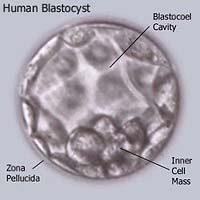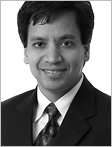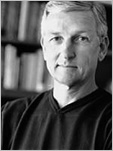 |
| Human blastocyst containing stem cells |
by Sharon Brock
The science and politics of stem cell research were presented last week by Deepak Srivastava, MD, director of the Gladstone Institute of Cardiovascular Disease, and David L. Gollaher, PhD, president and CEO of the California Healthcare Institute (CHI), as a part of Gladstone's Science for Life lecture series, held at the UCSF-affiliated J. David Gladstone Institutes, located adjacent to UCSF's Mission Bay campus.
Both adult and embryonic stem cells have the potential to offer insights into disease processes and to serve as tools for therapy. Srivastava noted the value of studying both types of cells, but for the purpose of the talk focused on embryonic stem cells.
Embryonic stem cells have the genetic potential, similar to the multifunctional potential of a Swiss Army knife, to give rise to any cell type in the body. Srivastava explained that although every cell in a person's body contains the same 30,000 genes, only a small fraction of them are expressed as proteins in a given cell, and that master genes determine which genes are expressed. Muscle cells, for example, must express the master genes for muscle while silencing those specifically required for other cell types, such as nerve cells, immune cells or endothelial cells.
"It's like a light switch," said Srivastava. "Master genes turn some genes off and others on, which creates the proteins that determine the cell type. In the lab, we use the same mechanism to guide mouse embryonic stem cells to create the cell types that we need."
Srivastava discussed a relatively new area of research called somatic cell nuclear transfer (SCNT), or therapeutic cloning. The goal of SCNT is to create patient-specific stem cell lines that would allow scientists to study the earliest stages of disease development and to create patient-specific, specialized cell types for transplantation to replace or replenish damaged tissues.
 |
| Deepak Srivastava |
Scientists have studied this technique with numerous types of animal cells, but are at the very earliest stage of studying this process in human cells.
In the SCNT process, Srivastava explained, DNA is extracted from a patient's cell and injected into an egg, or oocyte, from which the DNA has been removed. After three to five days, the egg has developed into a blastocyst, a ball of approximately 100 cells that includes embryonic stem cells.
Since the DNA of the embryonic stem cells originally came from the patient, scientists could potentially develop beating-heart cells in a culture dish and transplant them into patients with damaged heart tissue with a decreased chance of rejection. Likewise, they could develop insulin-producing cells, and transplant them into the pancreas of patients with diabetes.
UCSF and Harvard are the only US universities that have announced that they are carrying out SCNT research with human cells. In 2004 and 2005, a South Korean team reported success in carrying out SCNT, but their findings were proven to be fabricated.
Political Factors
There have been scientific challenges to every major medical discovery in history. Stem cell scientists have faced formidable challenges in both the scientific and political arenas, due to the controversial nature of the research.
"Stem cell research is one of the most politically charged scientific issues," said Gollaher, president of the CHI, a nonprofit public policy research and advocacy organization. "With the ongoing political backlash, we need to increase public education and manage appropriate expectations."
 |
| David Gollaher |
Gollaher presented a timeline of the politics surrounding stem cell research. In 1996, the first clone of an adult mammal, Dolly the sheep, fueled a political debate on the direction and regulation of stem cell science. The cloning of Dolly created fear that scientists might someday try to clone a human being.
Mainstream scientists have opposed the idea of cloning a human being - a process that would be "reproductive cloning" - from the outset, citing the likelihood of serious genetic risks in a cloned person. However, as a precaution, in 1996, President Bill Clinton implemented a ban on federal funding for reproductive cloning experiments, and created the National Bioethics Advisory Commission. On the state level, California enacted the California Cloning Act in 1997, which outlawed reproductive cloning of human beings, but allowed somatic cell nuclear transfer, or therapeutic cloning.
Meanwhile, some universities around the world had begun efforts to derive human embryonic stem cells from the embryos at the blastocyst stage. UCSF and University of Wisconsin were the two US universities that pursued the work.
On August 9, 2001, President George W. Bush announced that federal funding could be granted to study the embryonic stem cell lines that already existed, but would not allow funding for research of new cell lines. UCSF's and University of Wisconsin's stem cell lines qualified for inclusion in the NIH Embryonic Stem Cell Registry, and have been shared with many labs around the world.
However, many scientists and health care advocates consider the president's policy too restrictive, and have advocated for broader funding of embryonic stem cell research.
In response to the president's restrictions, in 2004, California voters passed Proposition 71, a $3 billion bond initiative for embryonic stem cell research in the state. However, litigation challenging the constitutionality of Proposition 71 has delayed sale of the bonds. Postdoctoral training grants have been awarded to 16 institutions, including the Gladstone Institutes and UCSF, but no funds have been granted specifically for research. On April 21 of this year, a California state court upheld the constitutionality of the proposition, making it likely that research funds will become available. The appeals process is expected to last until spring 2007.
Despite the many political setbacks and obstacles, scientists remain optimistic about the potential of embryonic stem cell research.
"I can't underestimate the level of rigor we need to put into every step, more than anything we've ever done in the past, due to both the scientific and political challenges," said Srivastava. "But with a reasonable amount of time, I think we can overcome these challenges, and I couldn't be more optimistic and enthusiastic about the future of this field."
Illustraion/Wikipedia
Links:
Stem Cell Facts
Gladstone Institute of Cardiovascular Disease


